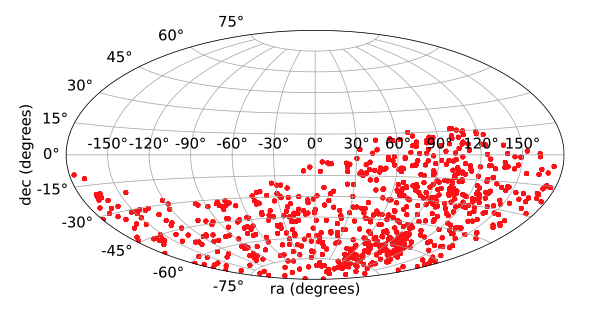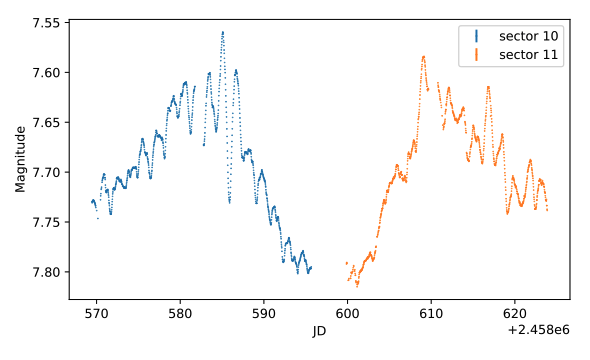STATUS UPDATE: Cycle 35, orbit two, TICA data now available for download at MAST
Hello TESS followers and welcome to this weeks news bulletin. This week we have three papers from the archive, enjoy!
Temperature and Distance Dependence of Tidal Circularization in Close Binaries: A Catalog of Eclipsing Binaries in the Southern Hemisphere Observed by the TESS Satellite (Justesen et, al., 2021):
Stars in close binary systems can experience tidal forces. Understanding these forces is important as they increase our knowledge regarding the formation and evolution of close binaries. Modeling tides is however very difficult, and significant uncertainties exist around their strength.
In this paper the authors investigate tidal circularization in close binaries by using a sample of well characterized TESS southern hemisphere eclipsing systems. By combining light curves and spectral energy distributions, the authors have derived the best-fit orbital and stellar parameters.
TESS data, in combination with data from Kepler and other ground-based facilities, were used to determine the eccentricity distributions of eclipsing binaries over a wide range of stellar temperatures (3000 - 50,000 K) and orbital separations (a/R1) = 2-300). A clear dependency between stellar temperatures and orbital separations in the eccentricities of the close binaries was found.
The authors go on to compare their observations with predictions of the equilibrium and dynamical tides. They find that cool binaries tend to agree with the predictions of equilibrium tide, but that warmer binaries i.e., those between 6,250K and 10,000K and which have an orbital separation of ~ 4-10, are found on circular obits and so contradict predictions of dynamical tides.
The paper goes on to suggest that some binaries radiative envelopes may be tidally circularised significantly more efficiently than usually assumed. Please read this fascinating paper for more information.
GG Carinae: Discovery of orbital phase dependent 1.583-day periodicities in the B[e] supergiant binary (Porter et. al., 2021):
GG Carinae is a binary system with an orbital period of ~31 days, and a B[e] supergiant primary. Using photometry from TESS, ASAS, OMC, and ASAS-SN, in addition to spectroscopy from the Global Jet Watch, the authors investigate the short term variability exhibited by the binary. A previously unknown periodicity of 1.583156 days was derived, and present in both the photometry and the radial velocities of the emission lines (He I, Fe II, Si II). The amplitudes of the short period variations in the photometry, and in some of the emission lines, are modulated by the orbital period of the binary. This makes it such that the short-period variations have the largest amplitudes when the binary is at periastron. The authors find that there are no significant changes in the phase of the short period variations over the orbital period.
The 1.583-day variability tends to agree well with the expected period of the 𝑙 = 2 f-mode of the primary given its mass and radius. The authors explain this could be cause by the primary being periodically pulled out of hydrostatic equilibrium by quadrupolar tidal forces when the components are near periastron in the binary’s eccentric orbit (𝑒 = 0.5) and the primary almost fills its Roche lobe. This effect would cause an oscillation at the 𝑙 = 2 f-mode frequency which is damped as the distance between the components increases.
TESS re-observes the young multi-planet system TOI-451: refined ephemeris and activity evolution (Barragán et. al., 2021):
TOI 451 is a young star that is host to three planets. In this paper the authors present a new analysis of the system using TESS Cycle 3 data. This new analysis of the transits of the three planets has improved the ephemeris of TOI 451 b and TOI 451 c, which will aid in future followup observations.
Updated mid-transit times are BJD − 2, 457 000 =1410.9896, 1411.7982 , and 1416.63407 for TOI451 b, c, and d, respectively, and the periods are 1.8587028 , 9.192453 , and 16.364932 days.
Using Gaussian Processes the out-of-transit light curve is also modeled with a quasi-periodic kernel. The results of this analysis indicate a change in the properties of the active regions on the surface of the host between Cycles 1 and 3. Please see this paper for more information.

Fig. 1: Taken from Justesen, et al., (2021). The distribution of detected TESS eclipsing binaries on the sky. The continuous viewing zone is visible as the over density of binaries around R.A = 90o, and Dec. = -60o.

Fig. 2: Taken from Porter, et al., (2021). The TESS light curve of GG Car

Fig. 3: Taken from Barragán et. al., (2021). Top panel: PDC-SAP light curve (grey) along with best-fit GP+transit model (red), for TESS Sectors 4 and 5. Also shown, with a vertical offset for clarity, are the de-trended light curve (blue) and the transit-only model (orange). Middle panel: same as top panel, but for Sector 31. Bottom row: de-trended light curves phase-folded at the period of each planet (individual data points in grey, phase-binned data in red) together with the best-fit transit model (black line), with the residuals in the lower inset.